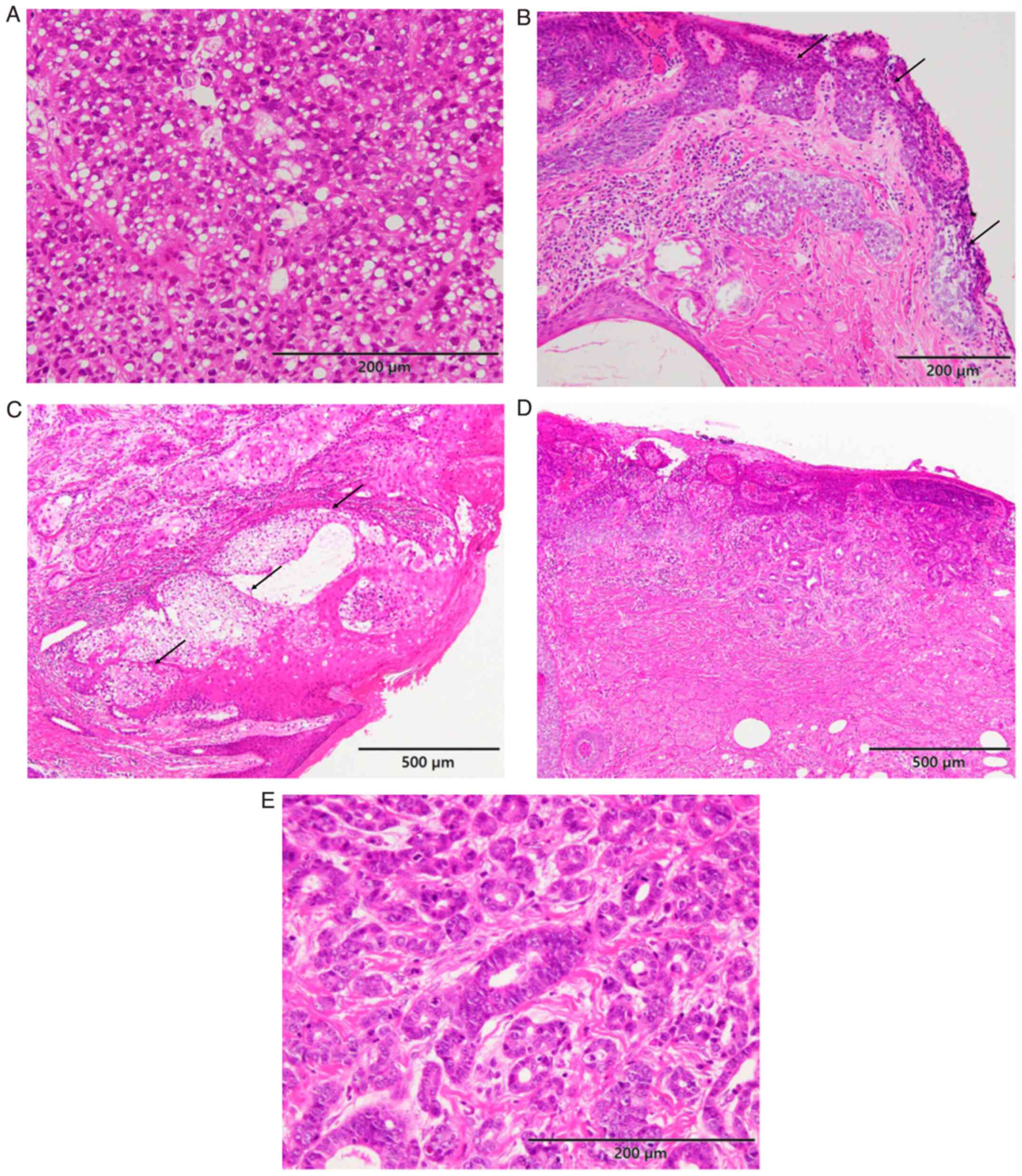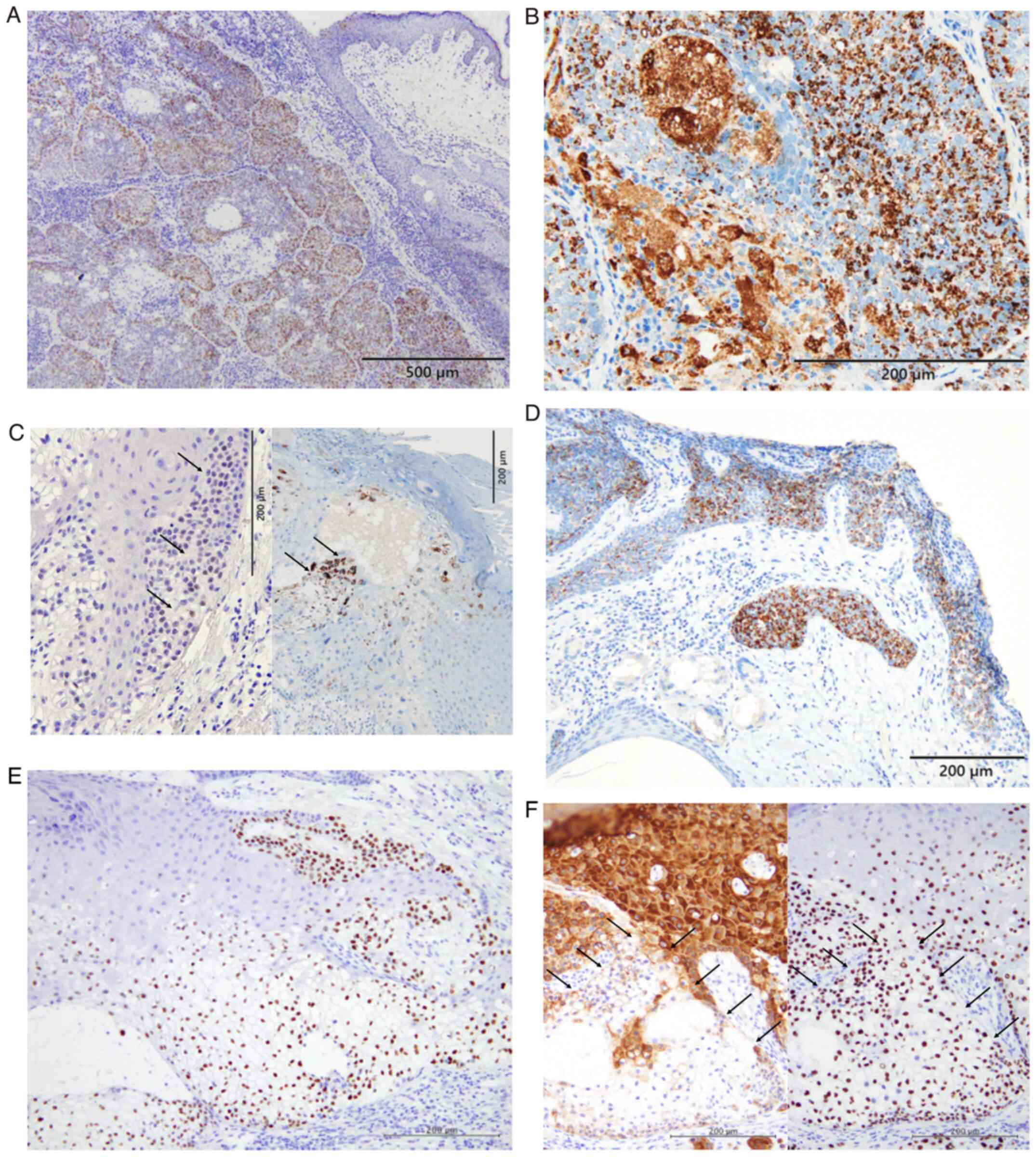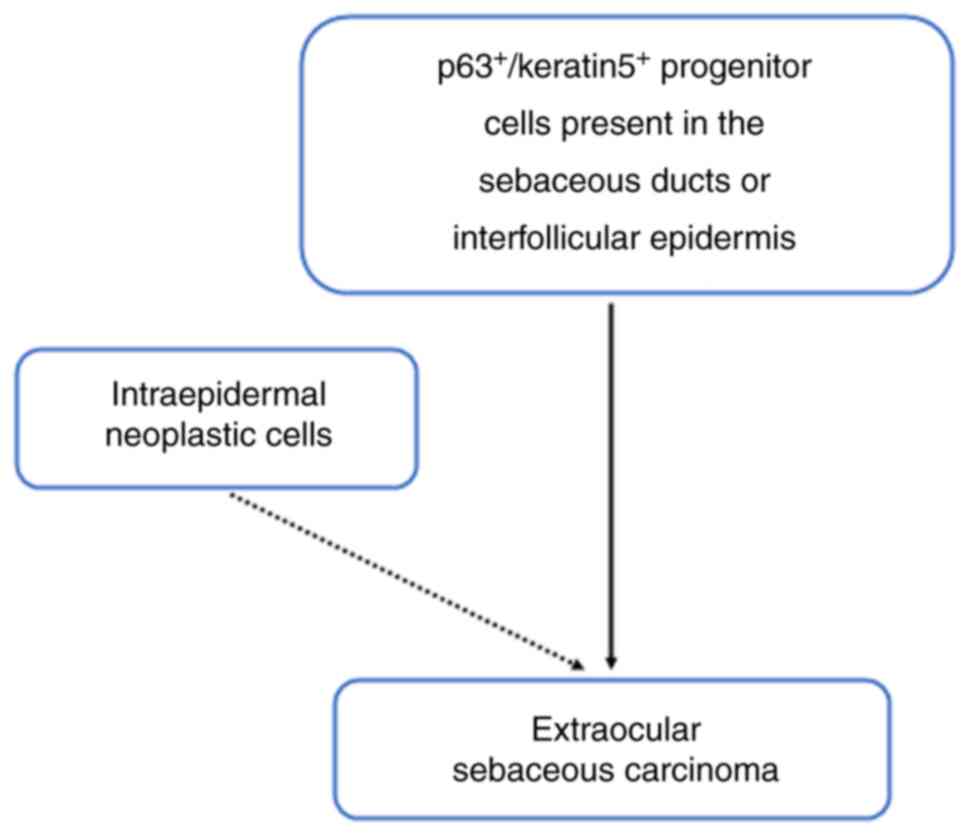|
1
|
Dubovy S, Eberhart CG and Vemuganti G:
Sebaceous carcinoma of the conjunctiva and caruncle. WHO
Classification of Tumours of the Eye. 4th Edition. IARC; Lyon: pp.
25–26. 2018
|
|
2
|
Wick MR, Cree IA, Kazakov DV, Lazar AJ,
Michal M, Sangüeza OP, Singh R, Wood BA and Zembowicz A: Sebaceous
carcinoma. WHO Classification of Skin Tumours. 4th Edition. IARC;
Lyon: pp. 211–212. 2018
|
|
3
|
Rao NA, Hidayat AA, McLean IW and
Zimmerman LE: Sebaceous carcinomas of the ocular adnexa: A
clinicopathologic study of 104 cases, with five-year follow-up
data. Hum Pathol. 13:113–122. 1982. View Article : Google Scholar : PubMed/NCBI
|
|
4
|
Kazakov DV, Kutzner H, Spagnolo DV, Rütten
A, Mukensnabl P and Michal M: What is extraocular cutaneous
sebaceous carcinoma in situ? Am J Dermatopathol. 32:857–858. 2010.
View Article : Google Scholar : PubMed/NCBI
|
|
5
|
Boecker W, Reusch M, Mielke V, Reusch U,
Hallermann C, Loening T, Tiemann M and Buchwalow I: Twenty-eight
cases of extraocular sebaceous carcinoma: A correlative
clinicopathological and immunohistochemical analysis of extraocular
sebaceous carcinomas and benign sebaceous gland tumors. Am J
Dermatopathol. 43:93–102. 2021. View Article : Google Scholar : PubMed/NCBI
|
|
6
|
Boecker W, Reusch M, Mielke V, Reusch U,
Loening T, Tiemann M and Buchwalow I: Spatial analysis of p63, K5
and K7 defines two groups of progenitor cells that differentially
contribute to the maintenance of normal sebaceous glands,
extraocular sebaceous carcinoma and benign sebaceous tumors. J
Dermatol. 46:249–258. 2019. View Article : Google Scholar : PubMed/NCBI
|
|
7
|
Namiki T, Miura K, Yokozeki H and Ansai
SI: Bowen disease with sebaceous differentiation: A case report and
immunohistochemical analysis of adipophilin and cytokeratin 1. Am J
Dermatopathol. 40:841–845. 2018. View Article : Google Scholar : PubMed/NCBI
|
|
8
|
Misago N, Kuwashiro M, Tsuruta N and
Narisawa Y: Sebaceous carcinoma in association with actinic
keratosis: A report of two cases with an immunohistochemical study.
J Dermatol. 42:616–620. 2015. View Article : Google Scholar : PubMed/NCBI
|
|
9
|
Aung PP, Batrani M, Mirzabeigi M and
Goldberg LJ: Extraocular sebaceous carcinoma in situ: Report of
three cases and review of the literature. J Cutan Pathol.
41:592–596. 2014. View Article : Google Scholar : PubMed/NCBI
|
|
10
|
Ishida M, Iwai M, Yoshida K, Kagotani A
and Okabe H: Sebaceous carcinoma associated with Bowen's disease: A
case report with emphasis on the pathogenesis of sebaceous
carcinoma. Int J Clin Exp Pathol. 6:3029–3032. 2013.PubMed/NCBI
|
|
11
|
Ishida M and Okabe H: Intraepidermal
sebaceous carcinoma occurring concurrently with actinic keratosis.
J Cutan Pathol. 39:731–732. 2012. View Article : Google Scholar : PubMed/NCBI
|
|
12
|
Nakashima K, Adachi K, Yamasaki A, Yamada
N, Yoshida Y and Yamamoto O: Sebaceous carcinoma with actinic
keratosis. Acta Derm Venereol. 90:196–198. 2010. View Article : Google Scholar : PubMed/NCBI
|
|
13
|
Ansai S and Mihara I: Sebaceous carcinoma
arising on actinic keratosis. Eur J Dermatol. 10:385–388.
2000.PubMed/NCBI
|
|
14
|
Escalonilla P, Grilli R, Cañamero M,
Soriano ML, Fariña MC, Manzarbeitia F, Sáinz R, Matsukura T and
Requena L: Sebaceous carcinoma of the vulva. Am J Dermatopathol.
21:468–472. 1999. View Article : Google Scholar : PubMed/NCBI
|
|
15
|
Oka K and Katsumata M: Intraepidermal
sebaceous carcinoma: Case report. Dermatologica. 180:181–185. 1990.
View Article : Google Scholar : PubMed/NCBI
|
|
16
|
Jacobs DM, Sandles LG and Leboit PE:
Sebaceous carcinoma arising from Bowen's disease of the vulva. Arch
Dermatol. 122:1191–1193. 1986. View Article : Google Scholar : PubMed/NCBI
|
|
17
|
Fulling KH, Strayer DS and Santa Cruz DJ:
Adnexal metaplasia in carcinoma in situ of the skin. J Cutan
Pathol. 8:79–88. 1981. View Article : Google Scholar : PubMed/NCBI
|
|
18
|
Yoshikawa K, Ishida M, Yanai H, Tsuta K,
Sekimoto M and Sugie T: Prognostic significance of adipophilin
expression in biopsy specimens of patients with triple-negative
breast cancer. Oncol Lett. 23:1272022. View Article : Google Scholar : PubMed/NCBI
|
|
19
|
Hashimoto Y, Ishida M, Ryota H, Yamamoto
T, Kosaka H, Hirooka S, Yamaki S, Kotsuka M, Matsui Y, Yanagimoto
H, et al: Adipophilin expression is an indicator of poor prognosis
in patients with pancreatic ductal adenocarcinoma: An
immunohistochemical analysis. Pancreatology. 19:443–448. 2019.
View Article : Google Scholar : PubMed/NCBI
|
|
20
|
Fujimoto M, Matsuzaki I, Yamamoto Y,
Yoshizawa A, Warigaya K, Iwahashi Y, Kojima F, Furukawa F and
Murata SI: Adipophilin expression in cutaneous malignant melanoma.
J Cutan Pathol. 44:228–236. 2017. View Article : Google Scholar : PubMed/NCBI
|
|
21
|
Ishida M and Okabe H: Sebaceous carcinoma
with apocrine differentiation (seboapocrine carcinoma). Pathol Int.
62:438–440. 2012. View Article : Google Scholar : PubMed/NCBI
|
|
22
|
Misago N and Narisawa Y: Sebaceous
carcinoma with apocrine differentiation. Am J Dermatopathol.
23:50–57. 2001. View Article : Google Scholar : PubMed/NCBI
|
|
23
|
Kazakov DV, Calonje E, Rütten A, Glatz K
and Michal M: Cutaneous sebaceous neoplasms with a focal glandular
pattern (seboapocrine lesions): A clinicopathological study of
three cases. Am J Dermatopathol. 29:359–364. 2007. View Article : Google Scholar : PubMed/NCBI
|
|
24
|
Pinheiro JAF and Lopes JMPB: Periocular
sebaceous carcinoma with apocrine differentiation: A case report
and review of the literature. Int J Surg Pathol. 27:432–436. 2019.
View Article : Google Scholar : PubMed/NCBI
|
|
25
|
Afroz N, Zaidi N and Rizvi SAR: Sebaceous
carcinoma with apocrine differentiation: A rare entity with
aggressive behavior. Indian J Pathol Microbiol. 56:408–410. 2013.
View Article : Google Scholar : PubMed/NCBI
|
|
26
|
Na HY, Choe JY, Shin SA, Choung HK, Oh S,
Chung JH, Park M and Kim JE: Proposal of a provisional
classification of sebaceous carcinoma based on hormone receptor
expression and HER2 status. Am J Surg Pathol. 40:1622–1630. 2016.
View Article : Google Scholar : PubMed/NCBI
|
|
27
|
North JP, Golovato J, Vaske CJ, Sanborn
JZ, Nguyen A, Wu W, Goode B, Stevers M, McMullen K, Perez White BE,
et al: Cell of origin and mutation pattern define three clinically
distinct classes of sebaceous carcinoma. Nat Commun. 9:18942018.
View Article : Google Scholar : PubMed/NCBI
|

















